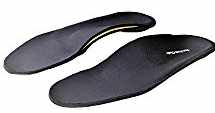Foot orthotics can play a role in reducing pain in several ankle conditions. These include ankle pain due to instability, ankle arthritis and ankle pain due to tendonitis. The best orthotic for ankle conditions is a custom total contact orthotic; however, you could start with an over-the-counter device. The best OTC arch support we have found for ankle pain is the FootChair Medical Grade Orthotic. The FootChair adjustable arch orthotic has the best arch height we have found on an over-the-counter arch support. It is the only OTC insole to have an adjustable arch using removable pads.
Orthotics for Ankle Pain and Instability
Orthotics have been shown in multiple studies to play a role in improving stability (and decreasing pain) in patients with chronic ankle instability. In fact, chronic ankle instability, which occurs as a result of ankle sprains that are not treated correctly, is the most common cause of achy and painful ankles. At least four separate studies have shown that in patients with a history of ankle sprain and subsequent ankle instability, the use of orthotics improved their stability1 – 4. Orthotics for this condition are prescribed to stabilize the ankle. The exact orthotic prescription will vary depending on your specific biomechanics but in general orthotics for ankle pain and instability will incorporate wedging that prevents turning the ankle.
Orthotics for Ankle Arthritis
Another ankle condition where orthotics are a useful tool is arthritis of the ankle. In this condition our goal is to use the orthotics to prevent excessive pronation of the feet which can lead to abnormal compression within the ankle joint and can be painful in patients who have arthritis. Orthotics for this condition are made to offer maximum support so they are going to be somewhat wider than average orthotics. It is also important that they conform extremely close to the arch of the foot (a total contact orthotic).
Orthotics for Ankle Tendonitis
There are two primary types of tendonitis that lead to ankle pain.
- Tendonitis on the inside (medial side) of the ankle – usually posterior tibialis tendonitis
- Tendonitis on the outside (lateral side) of the ankle – usually peroneal tendonitis.
These tendons have very different functions. The tendons on the inside of the ankle pull your foot in and the tendons on the outside pull your foot out. Since these two types of tendons have such different functions the orthotics for each are made very differently.
How Should Foot Orthotics for Ankle Pain be Prescribed?
As you can see there are a number of problems affecting the ankle that can be treated with foot orthotics. The important message here is that each of these orthotics is prescribed completely differently from the others. For example, if you have peroneal tendonitis our goal is to reduce tension on the peroneal tendons and if you have pain caused by arthritis, our goal is to use the orthotics to align the ankle joint in a manner to decrease pressure and motion at the damaged portion of the joint.
The key to getting the most effective orthotic for your ankle condition is to see a podiatrist who specializes in biomechanics and orthotic therapy. If you are in the Seattle / Puget Sound region contact us for an appointment. If you are outside of our area, find a podiatrist who specializes in orthotic therapy. If you would like to try some home remedies for ankle pain first, you can find suggestions here. If you are not better in three weeks, however, be sure to see a podiatrist.
Surgery for Ankle Pain is Always Last Resort
Surgery should be your last resort for treatment of ankle pain, instability and arthritis. Conservative treatment including proper rehabilitation and strengthening and orthotics designed specifically to improve your specific ankle condition will provide relief in most cases.
Video: Why Does My Ankle Hurt Months After I Sprained It?
REFERENCES
- MUNN J, ET AL. Eccentric Muscle Strength in Functional Ankle Instability. Med Sci Spot Exercise. 35: 245. 2003.
- ORTEZA LC, VOGELBACH WD, DENEGAR CR: The effect of molded and unmolded orthotics on balance and pain while jogging following inversion ankle sprain. J Athl Train 27: 80, 1992
- OCHSENDORF DT, ET AL. Effect of orthotics on postural sway after fatigue of the plantar fascia and dorsiflexors. J Ath Train 35: 26. 2000.
- GUSKIEWICZ KM, PERRIN DH: Effect of orthotics on postural sway following inversion ankle sprain. J Orthop Sports Phys Ther 23: 326, 1996.





